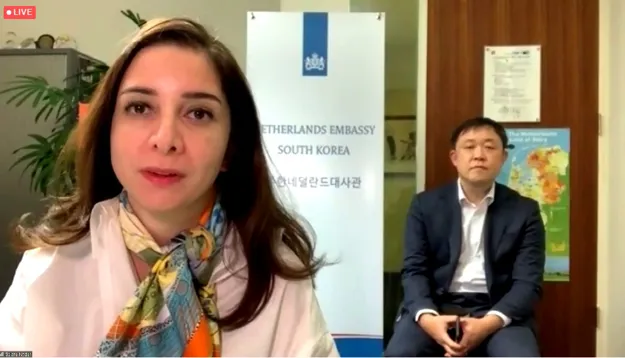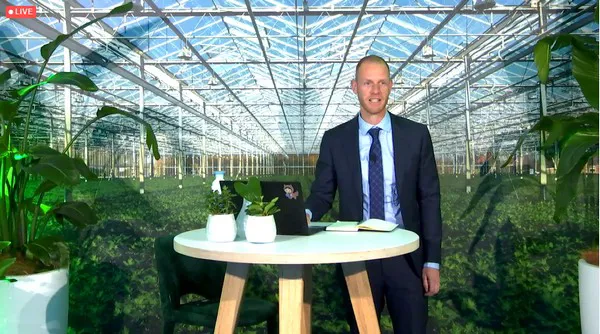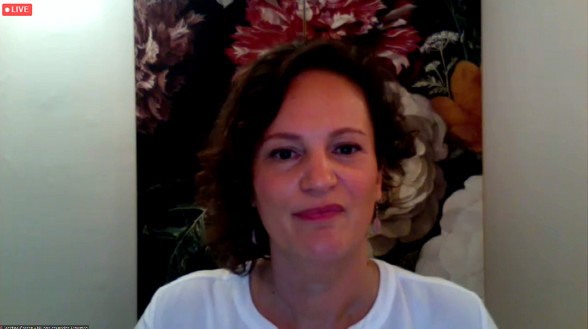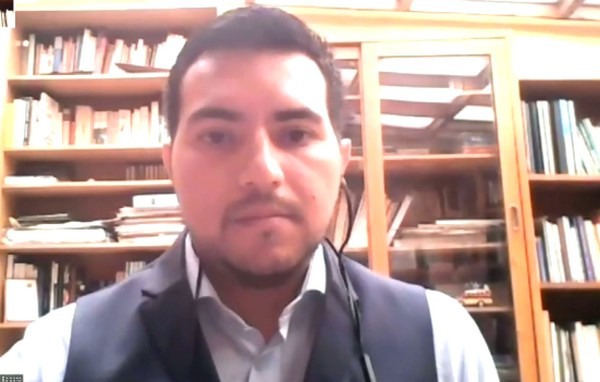For many years, Dutch horticulturalists are exporting their products and transferring their knowledge abroad. In many countries, the Dutch products and methods are being used, but there are always opportunities to expand further. In yesterday's Xpert Theatre webinars during the GreenTechLive & Online event, the Dutch business opportunities in South Korea (for the floriculture industry), Argentina and Colombia (for the vegetable industry) have been presented by the Dutch Embassies in these countries. Overall, we can see that there is a lack of knowledge among growers in these countries, which are mostly growing in low to medium tech greenhouses. Also post harvest loss is quite an issue for which they are eagerly looking for a solution. The Dutch Embassies stressed that they are very willing to help with any issues regarding entering this market.
 Drs. Gelare Nader and Agricultura advisor Mr. Kang.
Drs. Gelare Nader and Agricultura advisor Mr. Kang.
South Korea
In South Korea, the floriculture sector hasn't been growing over the recent years. The imports are rising, but the local production is declining, which results in no spectacular growth, explains Drs. Gelare Nader, Agricultural counsellor at Embassy the Netherlands in South Korea. Also the consumption is lower; cut flowers seem to be less popular in South Korea than in countries like Japan and China. However, as South Korea is nowadays a relatively rich country there is room for growth.
So how is the floral market situation in Korea. The imports value increased from 18 million euro in 2001 to 60 million euro in 2017 and even after the crisis of 2008-2010, the imports increased. Most imports flowers come from China, the Netherlands, Taiwan and Thailand. The most important flowers that are imported are chrysanthemums (91% from China), carnations (77% from Colombia), roses (mainly Ethiopia and Colombia), orchids (76% from Thailand) and tulips (100% from The Netherlands). Nader explains that the younger consumers are looking for new "unknown" varieties.
Besides import, there is also local production, however it declined over the years and there are many challenges. There are several production quality problems; consumers complain about a short vase life, thin stems, little homogeneity and high prices. This is mainly a result of the lack of knowledge among growers, lack of investments (investments are often not profitable as the companies are (too) small and as there are often no successors for the company), and rising labor costs and prices of essential input like starting materials, fertilizers and crop protection. On top of that, for the traditional use of flowers (ceremonies, and so on) a long vase life was not that relevant and not all growers can switch to the new wishes and requirements of the market.
It is an excellent market for electronics, gaming products, casinos, food, drinks, and - ar recent trend - camping and outdoor gear. These sectors - unlike the flower sector - work with highly professional marketing and advertising campaigns. So, according to Gelare, the South Korean cut flower market is in great need of investment in production (technology, education, training and so on), distribution (refrigerated technology and logistics, development of sales channels, training etc.), and marketing and consumption (more unique products, more marketing, more promotion in flower festivals and on tv for example, a careful pricing policy).
Particularly promising sectors for Dutch providers and investors in South Korea in the coming years are cut flower exports, flower bulbs, design and construction of greenhouse projects, cultivation technique for production in greenhouses, and training, education, crop management and advice.
For more information on business opportunities in South Korea, contact them at: [email protected]

Nico Smit, RVO business manager Latin America hosting the Argentina and Colombia sessions.
Argentina
When looking at Latin America and the vegetable sector, we see that there are business opportunities in Argentina as well. Leontine Crisson explains that even though the crisis, highly impacted the population and poverty levels have risen, the food chains have done really well, showing the resilience for this sector. However, there are things to improve. It is a complex sector with great challenges in post - harvest and processing technology. In sum, she mentions that specialized producers in Argentina are in search of innovative logistic and sustainable solutions, while product safety and waste management are the key drivers towards improvement in the Argentine Horti value Chain.

Leontine Crisson
Diana Frezza, MSc – Professor (Associate) of University of Buenos Aires shows that the country has 37 million cultivable hectares, but currently only 2 percent is used for the horticulture sector. 93 percent of the products grown in Argentina are sold in the country and the majority (75%) in green grocery (the remaining in the supermarket), but due to the pandemic, online sales increased. The main product sold is the potato (44%), followed by the tomato (12%) and union (11%). Only 7 percent (mostly chickpea, beans, onion, garlic, pea, potatoes and pumpkins) is being exported, mainly to Brazil (65%).

Diana Frezza
When looking at the production, around 7,000 ha is under greenhouse. The farmer size is small and medium and family type. The tech is medium and low - most are wooden greenhouses with plastic cover.
Even though there is much to gain regarding the greenhouse techniques, Frezza does not expect the growers to invest in new and more high tech techniques in the near future, due to the social economic circumstances. "High tech is too soon for Argentina", she says. However downsized and easy to use tech may have an future.
Frezza stresses that is much to gain in the area of reduction of losses and waste (42 percent of the product is being lost and wasted, mainly because of the poor knowledge of handling at harvest and post harvest) , safer products, and making systems more sustainable. It is necessary to reduce differences, improve and modernize the applied technology through new genetic materials - Frezza explains that the same tomato genetics are being grown outdoors as well as indoors - mechanization, biological control, greenhouses, control equipment, substrates (of which substrates from the Netherlands are quite limited) and fertilizers.
For more information on business opportunities in Argentina, contact them at [email protected].

Andres Santana Bonilla
Colombia
What about vegetables grown in Colombia? With Colombia's ever growing cities (in size and population) feeding the cities and sustainable development of the horticulture sector in Colombia is a priority for LAN Bogota, explains Andres Santana Bonilla, Agricultural Advisor. Horticulture has become top of their list and they are eager to make Colombia an agricultural powerhouse. However, there are challenges to overcome. Inadequate agro-logistics infrastructure, along with complex geographical characteristics - 75% of the rural areas are more than four hour away from one of the 18 main cities. This also entails high costs are also preventing farmers from exporting the products. According to Bonilla, out of the 106 agricultural products with export potential, only 36 are currently being exported. Food loss and waste (34 percent of which 62% percent are fruits and vegetables) is another factor to improve, as well as protected cropping offers opportunities. Nowadays, even though greenhouse technology is not new in Colombia (mainly used for the flower production), currently a big portion of vegetables are produced in open field systems.
So what are the Dutch perspectives for the development of the horticultural sector in Colombia? Arno van der Maden of N&S del Tropico highlighted several points out of their study "Taste the Future - Food for thought", conducted last year and published in June 2020. He explains there are three types of growers. Between 10-15 percent are determined to professional growers, mainly growing in medium tech greenhouses, supplying to chain stores in high strata and special restaurants. Hey grow mainly cherry tomato and different varieties lettuce, zucchini, bell peppers and have GAP and organic certifications. Then came the food producers who grow in lower tech greenhouses with some kind of mechanization and the more conventional products with hardly any GAP certifications. Last is food farmers who mainly grow on the field and have very basic greenhouse. Their customers are local, in the area, and the intermediation, till the product gets to the market, is high and products are not certified.
Over the years, the market has changed from the more traditional to the more special varieties, like colored peppers and tomatoes, tomatoes on the vine, organic and so on. The out of home market is rapidly growing with a larger demand for healthy products.
Poverty is decreasing in Colombia. The middle and higher class is growing and these classes are demanding for healthier and more expensive food products. Van der Maden explains that the middle income class consumes more veggies than the lower income class and the higher income class is more focused on the organic and certified products.
Regarding the supply chain, there is much to gain. There is a high level of intermediation, the traceability of fresh produce is low, as well as the offer of products, the transport distance of fruit and vegetables is large without a cold chain. In the future, he sees more direct deliveries, an increase in requirements for GAP food and safety in general, efficient and controlled logistics and less, recyclable or biodegradable packaging.
Also for the growers, there is much to gain. They are willing to improve their productivity but are reluctant in investing as the prices for their products are often based on supply and demand.
From this report, RVO developed a strategy with actions and recommendations aiming at increasing presence of Dutch companies and knowledge centres for the sustainable and inclusive development of Colombian horticulture. They suggest two approaches: one aimed at traditional (technical assistance with regard to agro-logistics and roundtable dialogues), low-tech growers (setting up a demonstration unit and Match making step by step) and another aimed at the emerging ‘next generation’ niche growers in Colombia. Finally, a few suggestions are made for a more general ‘explain, excite and
explore’ approach. (More can be read in the Taste the Future report)
For more information on the GreenTech Live & Online:
www.greentech.nl
